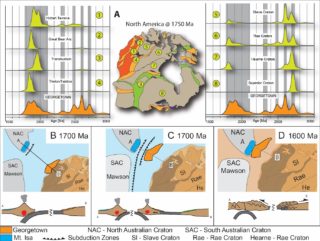A piece of America found in northern Australia
Legacy of the 1.6-billion-year-old supercontinent Nuna
Throughout Earth’s 4-billion-year history, as continents shift around the globe, periods occur where the continents amass to form supercontinents. Most recently this occurred about 300 million years ago to form the supercontinent Pangea, where the southern continents (Africa, South America and Australia and Antarctica) were connected to Eurasia and North America. It is now recognised that a supercontinent termed Nuna formed about 1.6 billion years ago. Although previous researchers have speculated that north-east Australia was near North America, Siberia, or North China in Nuna, solid evidence have been hard to find from the ancient rocks.
In Australia, approximately two thirds of the country consist of basement rocks older than 600 million years. In North Queensland, 1.7 billion-year-old rocks are found in Mt. Isa and 500 km away in the Georgetown region. New sedimentological field data in conjunction with new and existing geochronological data from both regions revealed an unexpected constituent of the Australian continent. As expected, in Mount Isa rocks, we found a strong resemblance to known Australian basement rocks. However, sedimentary rocks in Georgetown (Figure 1) revealed surprising signatures that are unknown in Australia. Instead, they show a strong resemblance to sedimentary rocks along present-day Canada, sourced from American basement rocks (Figure 2).

The simplest explanation for our findings is that at 1.7 billion-year ago when the Georgetown rocks were deposited in a shallow sea, the Georgetown area was part of North America. It then rifted from North America, and only collided with the Mt Isa region of northern Australia at around 1.6 billion-year ago when almost all continents on Earth at the time assembled together to form a Pangea-like supercontinent called Nuna (Figures 2 & 3). When Nuna broke apart some 300 million years later, the Georgetown area had become a new piece of real estate permanently stuck to Australia.

In Mount Isa we find evidence of mountains being built as Georgetown collided with the rest of Australia. Interestingly, this mountain belt, in-contrast to the Himalayas, would not have been as large. To explain this, in our recently published paper in the journal GEOLOGY, we evoked a double-sided subduction model. Another possibility is that the Earth during this period was hotter and was unable to support the immense mountain belts we see on the modern Earth. This question is currently still being investigated by the Earth Dynamic Research Group at Curtin University.

Contact person: Zheng-Xiang Li, Earth Dynamics Research Group, Curtin University.
Relevant publication:
Adam R. Nordsvan, William J. Collins, Zheng-Xiang Li, Christopher J. Spencer, Amaury Pourteau, Ian W. Withnall, Peter G. Betts and Silvia Volante, Laurentian crust in northeast Australia: Implications for the assembly of the supercontinent Nuna. Geology, Volume 46, Issue 3, pages 251-254 (2018); https://doi.org/10.1130/G39980.1.
Read the Curtin University Media Release:
Related articles:
The Guardian, Newshub, ScienceAlert, Canning Times, Tdnews, IFLScience, The Inquisitr, Outer Places, Live Science, New York Daily News, MLive.com, Newsweek, ValueWalk, ZME Science, New Atlas, The North West Star, Digital Journal, The Sydney Morning Herald, Daily Mail, USA Today, Popular Science, News.com.au, National Geographic, Atlas Obscura.
TV News Story:
Radio Interviews:
BBC Radio 5 (Interview from time 3:55:01), 6PR 882.
